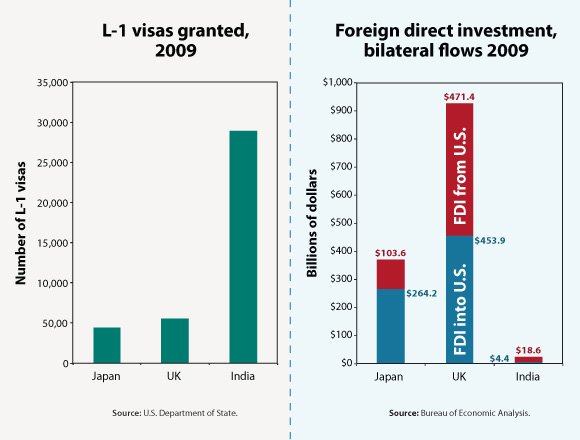The L-1 temporary worker visa category is used by multi-national companies to transfer their managers, executives and personnel with specialized knowledge who are employed in offices abroad to work in their corporate parent, subsidiaries or affiliates in the United States. The U.S. Chamber of Commerce, along with organizations such as the American Council on International Personnel and other groups which lobby on behalf of companies that use foreign guest workers, have long argued that the L-1 visa facilitates foreign direct investment (FDI) in the United States. In fact, there is little relationship between use of the visa and foreign direct investment. As the Figures show, the bilateral flow of FDI between India and the United States was miniscule compared to that of Japan and the U.K., two of America’s biggest trading partners, but Indian nationals received far more L-1 visas than Japan and the U.K. combined. In fact, 45% of all the L-1 visas granted in 2009 were issued to Indian nationals.

Why do Indian citizens receive so many L-1 visas, while Indian firms invest so little in the U.S.? As EPI research has shown, offshore outsourcing firms are the biggest users of the L-1 visa. These firms – both Indian and American multinational corporations such as IBM, HP, Cognizant Technology Solutions, Tata Consultancy Services and Wipro Limited, – are exploiting the L-1 visa program to import lower-level, rank and file employees from India as a source of cheap, temporary labor that displaces U.S. workers and moves American jobs overseas. L-1 employees have limited employment rights, employers are not required to pay them prevailing or market wages, and there is no legal limit on how many L-1s can be brought to the U.S. every year – as a result, corporations have strong incentives to hire and prefer L-1 workers from abroad.
This outcome reflects the reality that the system for administering and granting L-1 visas contains large programmatic loopholes.
A new EPI report by Rochester Institute of Technology professor and EPI Research Associate Ron Hira explores in detail the fundamental design flaws inherent in both the L-1 and H-1B visa guest worker programs.
